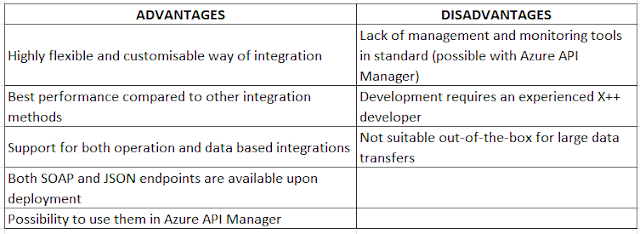1) OData (Open Data Protocol)
OData is an open source protocol to serve and consume interoperable data using common query operations with RESTful APIs. D365FO exposes all its public data entities as OData endpoints, which can then be accessed using the following URI format :
https://<env>.cloudax.dynamics.com/data/<EntityName>
OData provides a quick, codeless data integration method with many data query options and CRUD operations. You can use its open standard query string language to query your data and do data manipulations using standard OData CRUD commands, all using just simple and open standard REST calls. If you would like to call a custom method within your data entity, this is also supported by exposing custom actions with your OData entities, so the commands are also extendable to a certain point.
You can definitely use OData for your own integration projects, but there are also many OData-ready software available today, and these can be directly connected to D365FO OData endpoints. Microsoft Power BI also supports OData connection, and you can connect Power BI using OData if you feel lazy with setting up faster data integration possibilities, like Entity Store and Data Lake integrations.
Although it looks like the optimum way of data integration with D365FO, there are some drawbacks involved. OData queries and data operations are executed really slowly, and data reading may take ages if you try to retrieve a large entity. OData is mainly designed for simple CRUD operations and simpler queries. If you need to execute complex queries, like complex joins and lookups, for example, you may start to hit its limits.. Although you can add some custom actions to extend available OData commands with your own ones, complex operations and business logic unfortunately do not go very well with it. It may be required to place this complex logic in a consumer application if you decide to integrate it using OData.
There is also a rather new feature of D365FO to throttle calls to OData endpoints by giving priorities to them, to avoid system lockdowns that might be caused by frequent OData calls. You can read more about it from the link below :
🔍 Learn more:
Priority-based throttling overview | Microsoft Learn
Remember, you can also use OData endpoints in Azure API Manager, just like custom services.
✅ Best for lightweight, real-time CRUD operations.
🔑 Authentication
Like all external D365 FO integrations:
✅ Register an Azure AD app.
✅ Use OAuth 2.0 to get a bearer token.
✅ Send the token in the
Authorizationheader: Authorization: Bearer <access_token>
2) Custom Services (X++)
AIF services used in Dynamics AX are now upgraded to custom services in FO, and they are automatically published into SOAP and JSON REST endpoints when deployed. However, management and monitoring tools used for old WCF AIF services have now disappeared, leaving just naked, non-configurable service endpoints.
When you deploy a custom service, the following endpoints are created and you can call them remotely using standard AAD OAuth authorization and SOAP/REST HTTP calls:
REST (JSON): https://<baseUrl>/api/services/<ServiceGroup>/<ServiceName>/ https://<baseUrl>/soap/services/<ServiceGroup>/<ServiceName> ✅ Use when OData can't support complex validations or custom workflows.
🔑 Authentication
Like all external D365 FO integrations:
✅ Register an Azure AD app.
✅ Use OAuth 2.0 to get a bearer token.
✅ Send the token in the Authorization header: Authorization: Bearer <access_token>
✅ Register an Azure AD app.
✅ Use OAuth 2.0 to get a bearer token.
✅ Send the token in the Authorization header: Authorization: Bearer <access_token>
🔍 Stay tuned for more D365FO technical posts
📌 Bookmark: https://d365fohunt.blogspot.com

